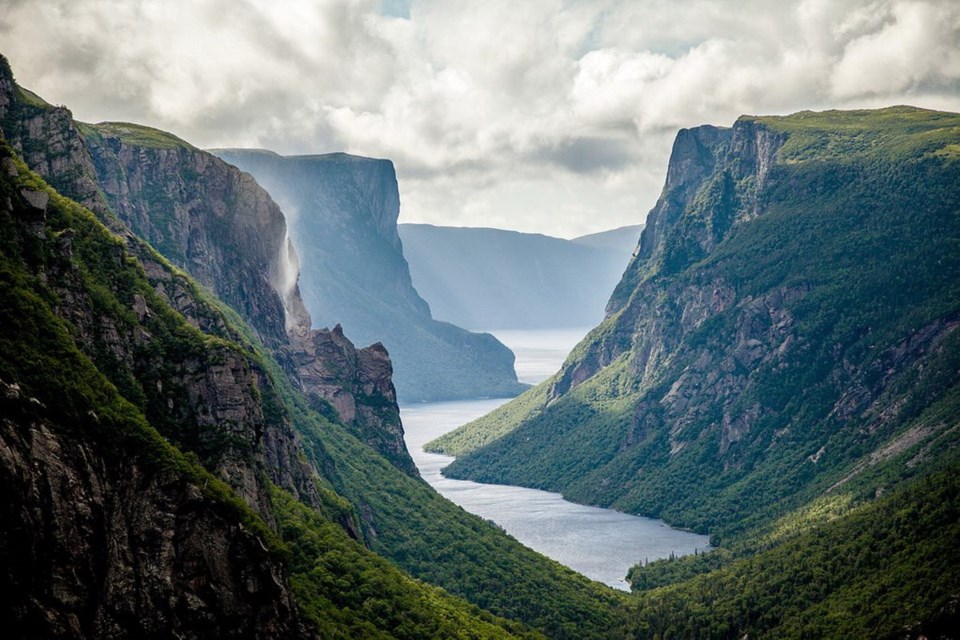GROS MORNE NATIONAL PARK, N.L.
You don’t have to take your hiking boots on a visit to Gros Morne National Park, but why wouldn’t you?
True, breathtaking vistas abound from winding, undulating roads that, in typical Newfoundland fashion, frequently leave you asking if you can get there from here. But it takes stepping onto one of the many easily reached trails to find places so quiet that the blood coursing through your ears is the only sound. Where panoramic views entice and humble. Where the landscape embraces the soul.
“Gros Morne National Park provides a haven not only for plants and animals but also for the human spirit,” a park brochure says. “It is possible to experience the ocean, the boreal forest and the Arctic-alpine conditions of Gros Morne Mountain, the highest point in the park … all in a single day.”
These trails were made for summer hiking — some short and gentle, others all-day and rugged. All are rewarding, even when traipsing through the gloom of Newfoundland fog — Gros Morne does, after all, translate via Google to “big dreary” — or basking in the sunshine that warms and transforms the land.
Whether you’re driving or hiking, kayaking or cycling, it’s not hard to see why Gros Morne National Park on the west coast of “the Rock” has been designated a world heritage site.
Named after its highest peak, the park covers 1,805 square kilometres that take in picturesque shoreline villages, fjords, cliffs and forests.
Divided by the 25-kilometre fjord called Bonne Bay into north and south sections, Gros Morne offers a rare modern-day sense of freedom — a sense that no one is looking over your shoulder, that most everyone you encounter along your way, who come from far and near, have left any pretensions at home to simply enjoy what is.
The park itself is easily reached via a short drive from Deer Lake, which is connected by direct flights from cities such as Toronto, Halifax, or St. John’s. Longer drives from St. John’s or from the ferry terminal at Port aux Basques make for a journey as fascinating as its destination.
In the park, admire rare flora or the ubiquitous pitcher plant — the province’s floral emblem. Rest up in an oversize red chair and take in the panoramic vistas from 300 metres up at the end of Lookout Trail.
Discover a rare example of continental drift made visible on the Tablelands, between Trout River and Woody Point in the southwest of the park. Normally hidden, the Earth’s mantle is exposed on the Tablelands — a red-brown rocky area believed to have been forced to the surface several hundred million years ago. With a little imagination, it could double for Mars, without the inhospitality.
Visitors can also stroll kilometres of beach or admire any of the scores of waterfalls.
Two impressive visitor centres at Rocky Harbour and Woody Point are good places to get your bearings and learn about the park and its diversity — recommended if making your first foray into an area that’s surprisingly large and where, given the topography, drives or rides can take a lot longer than expected. The park is cycle friendly, while grabbing a water shuttle between Norris Point and Woody Point makes for a fun ride in and of itself.
Accommodation varies from tent sites to upscale inns and charming bed and breakfasts — not much by way of chain hotels. It’s a good idea to make sure space is available in advance. Given the park’s proximity to Deer Lake, staying in town and doing day trips into the park is also perfectly feasible.
Being Newfoundland, rain and dramatic cloud cover are omnipresent possibilities that have to be embraced — the more to enjoy the golden hues and blue skies when the sun does break out. While many park activities only kick into gear for the short, intense summer season, park winters do offer Nordic skiing and snowshoeing.
No visit to Gros Morne — or to anywhere else in the province — would be complete without engaging the local residents: the friendly, welcoming people with their powerful sense of community and history, and their easy-flowing, natural storytelling ability in which lilting English and turns of phrase can at times puzzle the uninitiated.
———
If you go:
- Check http://visitgrosmorne.com/ for information and a list of daily activities.
- Pick up a copy of Tuckamore, the Parks Canada guide, to learn where the prime attractions are and for planning drives, hikes or boat rides.
- Pack clothing appropriate for at least two seasons, including items for wet and cool weather (temperatures can fall to single digits, even mid-summer).



